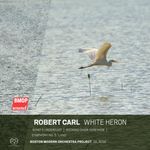|
Back
04/24/2021
Robert Carl: White Heron [1] – What’s Underfoot [2] – Rocking Chair Serenade for String Orchestra [3] – Symphony n° 5, “Land” [1]
Boston Modern Orchestra Project, Gil Rose (conductor).
Recording: Jordan Hall, Boston, Massachusetts (March 21, 2017) [1], (May 8, 2019) [2], Distler Hall, Tufts University, Somerville, Massachusetts (June 4, 2018) [3] – 59’52
BMOP/sound 1076 – Booklet in English

   
Nothing could be more natural than contemporary art and music. I learned this from a professor many years ago. Instead of trying to explain why moderns such as Mondrian and Albers were great artists, she had us look through a microscope at the patterns and shapes taking form and moving themselves into distinctive relationships in the natural world. These images, even more than the way we see the ordinary world day-to-day, are the most real, the most fundamental, she said. Suddenly, Miró with his whimsical amoebae and the splotchy collages of Krasner were not rebellions against reality but affirmations of what is essential at the core.
This approach works with music, as well. The compositions of Robert Carl in his new album, White Heron, reflect the sound pitches, patterns, and everyday discords we hear in small secluded ponds as well as sprawling canyons and dusty plains. It’s not exactly program music, perhaps closer to Impressionism, but there is an intimate familiarity about it even to a listener who has not heard Carl’s work before.
It is the sensation of lying under a peach tree on a spring day or reaching the top of a hill after an hour-long climb through sour grass and mountain laurel. We can hear it in other composers who have had these experiences and translated them into song, in Copland, Beech and Ives, though Carl’s work may be more subtle and refined.
The album opens with what I suspect is one of the most popular of this American composer’s works, the White Heron of the album’s title. Carl states that this work was inspired by close observation of avian life in the Florida Keys. Indeed, I’ve heard nothing in music before to match this atmospheric depiction of birds and other creatures in a moment (nine minutes, actually) captured in time and space. In this and in the other three works on the album, Carl expresses a world of ideas and feelings with a minimum of fuss.
Yet Carl is not a minimalist by any means but achieves transparency in part by using sheer curtains of sound rather than plodding chordal chunks. Why use an entire string section when a solo violin will do? Why assault ears with blaring brass when a single trumpet can match wits with a drum or keyboard? This latter effect comes in the second work on the album, What’s Underfoot, a work with a light, engaging texture, not nearly as ponderous as the descriptions in the accompanying booklet would have us believe.
On the other hand, the third selection, Rocking Chair Serenade, is less whimsical, more structured than its title suggests. There is a sense of repetitive grasping and releasing, a series of upward octave jumps from a row which sinks slowly downward. Are these the features of a squeaky rocking chair or abstract encounters with space and time?
The Boston Modern Orchestra Project (BMOP), under the direction of Gil Rose, provides impeccable musicianship throughout the album which concludes with Carl’s Symphony n° 5, “The Land”. This is a large-scale work which reflects on travels from the Midwest to the Rocky Mountains. Such a journey provides the philosophically inclined with many opportunities to consider musical structures as well as rock formations, and this Carl achieves by filtering ideas through the grid of experience. The Symphony n° 5 is divided into five sections, some subdivided further. The work ends mysteriously in a movement titled, “The Land Beyond”, with bell-like tones and the decrescendo of woodwinds. If the nature references remind us of Zen art forms, apparently Carl feels a link with Asian culture as well. In addition to his career as a composer and chair of composition at the University of Hartford, he plays the shakuhachi flute.
Whether regarded for its atmospheric reverence for nature or deep intellectual (or spiritual) reflections on the meaning of time and space, White Heron is essential listening, and an entrée for many to the music of a modern American master.
Linda Holt
|